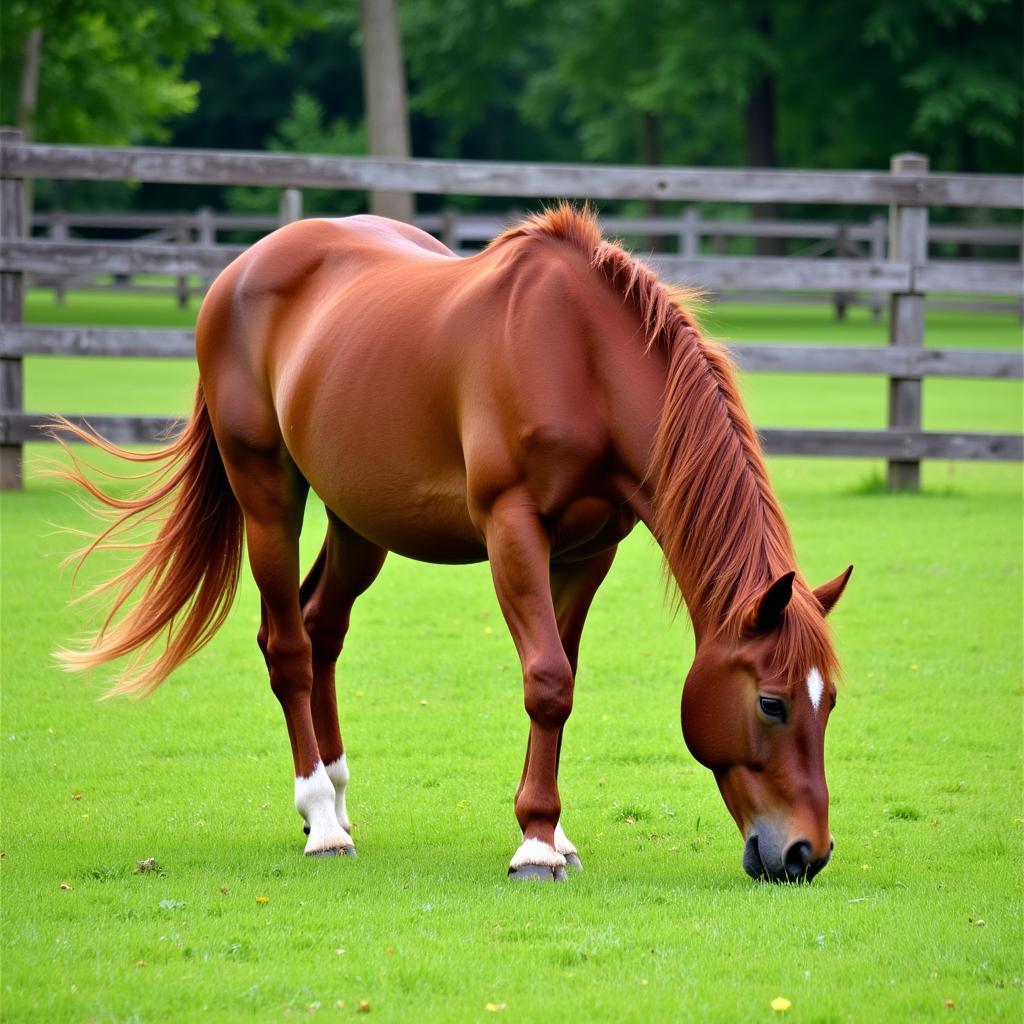Owning a Happy Horse Farm is a dream for many equine enthusiasts. It’s a place where horses thrive and their human companions find joy in their care. But what exactly makes a “happy horse farm,” and how can you create one? This guide delves into the essential elements that contribute to a thriving and joyful environment for both horses and humans on your very own horse farm.
Understanding the Needs of a Happy Horse
 Horse happily grazing in a lush pasture
Horse happily grazing in a lush pasture
Before building the perfect happy horse farm, you need to understand the core needs of your equine companions. Horses are herd animals with specific requirements for their physical and mental well-being. Let’s break these down:
The Importance of Socialization
Horses are naturally social animals, thriving in the company of their kind. A happy horse farm prioritizes herd interaction. This means providing ample space for horses to roam together, graze side-by-side, and engage in natural social behaviors like playing and grooming.
- Pasture buddies: Consider keeping horses in compatible pairs or small groups to foster a sense of companionship and security.
- Minimize Isolation: Avoid isolating horses for extended periods, as this can lead to stress and behavioral issues.
Ample Space to Roam
Confining these majestic animals to small stalls goes against their very nature. A happy horse farm offers plenty of turnout time in spacious pastures.
- Free Movement: This allows horses to move freely, graze at will, and engage in natural behaviors, which is crucial for both their physical and mental well-being.
Nutritional Considerations for a Happy Horse
A balanced diet is fundamental to a happy horse. High-quality hay should form the foundation of their diet, supplemented with grains, minerals, and fresh water.
- Forage First: Provide constant access to fresh, clean water and ensure they have access to hay for the majority of the day.
- Consult a Professional: Consult with an equine nutritionist to create tailored feeding plans based on each horse’s age, workload, and health condition.
Creating a Safe and Enriching Environment
A happy horse farm extends beyond basic needs; it incorporates elements that enrich their lives and keep them mentally stimulated.
- Environmental Enrichment: Provide toys, scratching posts, and varied terrain within their pastures to alleviate boredom and encourage natural foraging behaviors.
- **Consider clicker training or groundwork exercises to provide mental stimulation and strengthen your bond.
Building Your Happy Horse Farm
Now that you understand the core elements, let’s explore how to bring your happy horse farm vision to life.
1. Safe and Spacious Housing
- Stalls: Design stalls with ample space for horses to comfortably lie down, roll, and move around.
- Ventilation: Ensure proper ventilation within the barn to minimize dust and maintain good air quality.
- Bedding: Choose dust-free, absorbent bedding materials like wood shavings or shredded paper.
- Regular Cleaning: Establish a consistent cleaning routine to maintain a hygienic living environment.
2. Lush and Safe Pastures
- Fencing: Invest in safe and sturdy fencing, such as wooden planks or vinyl, to prevent escapes and injuries.
- Regular Maintenance: Regularly inspect and maintain fences to ensure they remain in optimal condition.
- Pasture Rotation: Implement a rotational grazing system to prevent overgrazing and promote healthy pasture growth.
3. Enrichment and Training
- Obstacle Courses: Create simple obstacle courses within the pasture using poles, tires, or natural elements.
- Clicker Training: Introduce clicker training to teach your horse fun tricks and strengthen your bond.
- Trail Riding: Explore local trails to provide your horse with mental stimulation and a change of scenery.
4. Routine Veterinary and Farrier Care
- Regular Check-ups: Schedule routine veterinary checkups for vaccinations, dental care, and general health assessments.
- Hoof Care: Arrange for a qualified farrier to trim and shoe your horse’s hooves every 6-8 weeks.
FAQs About Happy Horse Farms
Q: Can I have a happy horse farm with just one horse?
A: While horses thrive in herds, you can create a happy environment for a single horse with proper care and companionship. Consider miniature horses or goats as pasture companions and provide ample enrichment opportunities.
Q: How much land do I need for a happy horse farm?
A: The ideal acreage depends on the number of horses and your pasture quality. As a general guideline, aim for a minimum of one acre per horse.
Q: What are some signs of a stressed or unhappy horse?
A: Look out for changes in appetite, weight loss or gain, dull coat, pawing, weaving, cribbing, and aggressive behavior.
Finding Joy in the Journey
Creating a happy horse farm is an ongoing process of observation, adaptation, and dedication. By understanding the needs of your horses and prioritizing their well-being, you’ll cultivate a haven where they can thrive and you can find endless fulfillment in their care. For more information on specific horse breeds, like comparing Clydesdale horse to a regular horse, or finding the perfect long horse riding coat, explore more on JustusHorses.com.
Remember, a happy horse farm is a partnership built on trust, respect, and a shared love for these magnificent creatures. By prioritizing their well-being, you’ll create a harmonious environment where both horses and humans can thrive together. For any further assistance or personalized guidance, reach out to our dedicated team at Justus Horses USA. Contact us at 0772127271, email us at [email protected], or visit us at QGM2+WX2, Vị Trung, Vị Thuỷ, Hậu Giang, Việt Nam. We’re here to support you on your journey to creating an equine paradise.